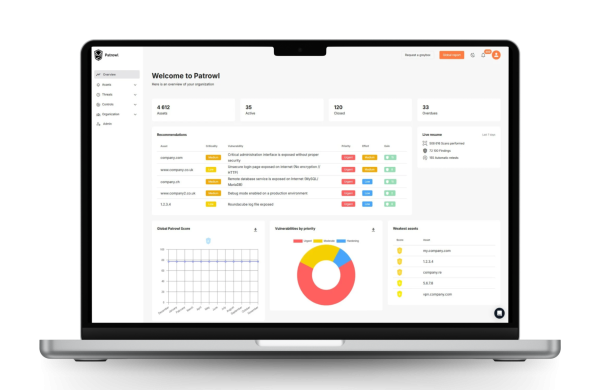Platform
| Criteria | Pentest | VULNERABILITY SCANNER |
|---|---|---|
| Approach | In-depth evaluation, attack simulation | Checking patches for CVE vulnerabilities |
| Frequency | Occasional (1-2 times a year) | Continuous or at regular intervals |
| Required expertise | Produced by cybersecurity experts | Requires configuration and supervision |
| Scope of analysis | Defined in advance by the experts | Limited to items declared in advance |
| Coverage | Targeted, in-depth analysis | Less complete, may leave gaps outside scope |
| Alert quality | Qualified alerts, few false positives | Often filled with false positives |
| Remediation | Tailored, detailed recommendations | Generic, not context-specific |
| Monitoring | One-off, with final report | Operates on scheduled cycles |
| Cost | High (carried out by experts) | Less costly to deploy |
| Examples of vulnerabilities |
CVE, OWASP, configuration errors, leaks | Mainly known vulnerabilities |
| Limitations | Limited frequency, high cost | False positives, limited perimeter |
Difference between vulnerability scanner and Patrowl's continuous pentesting
Continuous Pentesting
Safety approach :
Patrowl provides comprehensive security, similar to penetration tests, but on a continuous basis, identifying various vulnerabilities such as CVE, misconfigurations, OWASP threats, and data leaks.
CONTINUOUS PENTEST
Expertise required :
Patrowl operates automatically, reducing the need for advanced management expertise.
Continuous Pentest
Scope of analysis :
Patrowl constantly discovers everything on the Internet, guaranteeing complete coverage.
CONTINUOUS PENTEST
Alert quality
Patrowl only alerts on qualified vulnerabilities that present a real risk to your information system.
Continuous Pentest
Remediation
Patrowl offers complete, detailed remediations, suitable for non-experts, with configuration or command examples to help you quickly correct any identified flaws.
ROI: 287% with Patrowl
Let us manage time-consuming tasks and focus on remediation.
PATROWL COMBINES THE BEST OF BOTH APPROACHES:
The automation of scanners and the expertise of penetration testing for a comprehensive, continuous, and proactive solution.
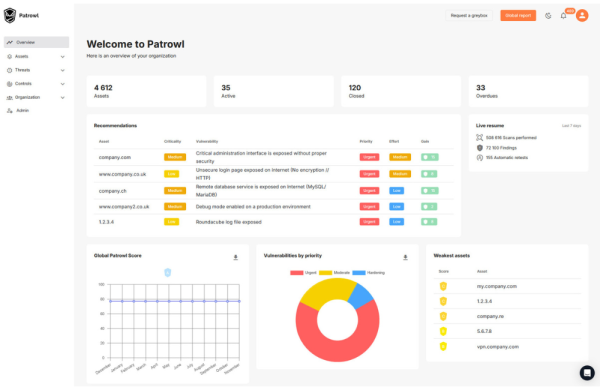
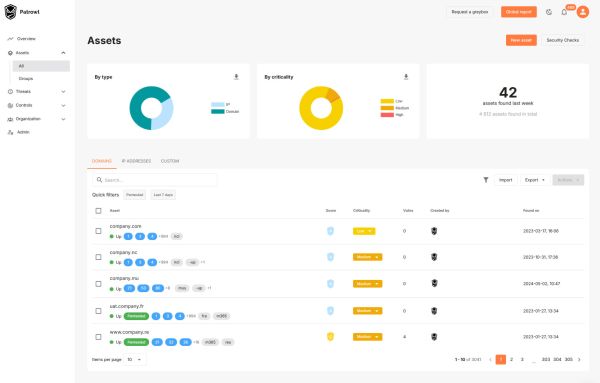
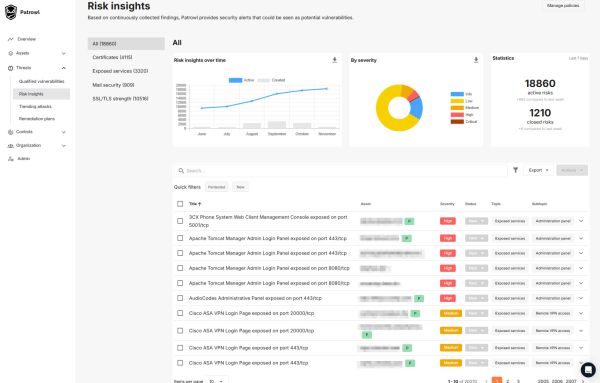



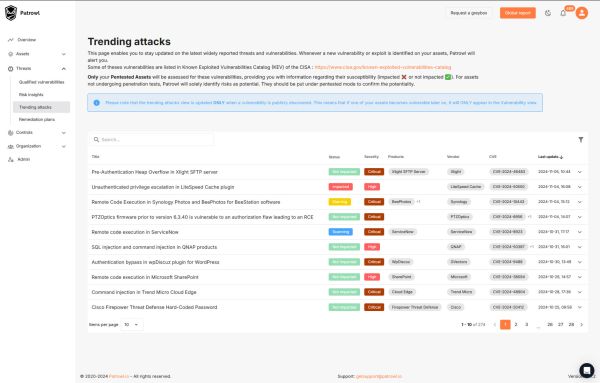
Why choose Patrowl to secure your external attack surface?
Zero false positives
Focus only on qualified risks and vulnerabilities.
Zero setup required
Quick, easy deployment in around 30 minutes.
24/7/365
Secure access with encryption and MFA/SSO authentication.
Simplicity
SaaS with no maintenance or programming on the customer side.
100%
Customer renewal rate in 2024.
Awards
Winner of the Assises de la Cybersécurité innovation awards (2022/2023).
Standards used for our pentests and scans:
PTES: Penetration Testing Execution Standard
OWASP: Web Application Security
SANS: Securing and auditing applications and services
GDPR: General Data Protection Regulation
ANSSI SDE NP: ANSSI password recommendations
Certifications of our experts and pentesters:
SANS GIAC GPEN GWAPT GXPN
Programme de formation avancée pour experts avec une expérience significative
OSCP: Offensive Security Certified Professional
SWE Certification
Offensive Security Web Expert
Patrowl’s unique approach for continuous external attack surface protection
Patrowl provides proactive, continuous security with automated vulnerability testing and the expertise of its pentesters. The platform helps analysts control vulnerabilities and strengthen their defenses by:
Continuous Asset Discovery: Identification of exposed systems, including unknown ones, through External Attack Surface Management (EASM).
Automated Pentesting: Continuous penetration testing to detect threats before they are exploited.
Risk Prioritization: Ranking threats based on their urgency and potential business impact.
Rapid Remediation: One-click remediation plans and clear alerts for immediate action
To conclude
Why are traditional pentests and vulnerability scanners ineffective?
How a vulnerability scanner works
Typically, a vulnerability scanner identifies security flaws using a database of known vulnerabilities. It can detect software flaws and, depending on the tool, assign a risk score.
Limitations of Vulnerability Scanners
Unqualified Reports: Often generate false positives, requiring significant time for analysis.
Limited Scope: Only cover what is explicitly declared, potentially leaving critical areas unexamined.
Lack of Context: Generic remediation recommendations that don’t consider each organization’s specifics.
Intermittent Monitoring: Operate on scheduled cycles, leaving exposure periods between scans
Pentesting: A comprehensive yet costly evaluation
A penetration test simulates attacks to identify security flaws. Unlike scanners, it is conducted by cybersecurity experts and includes in-depth analysis.
Limitations of Pentesting
Limited Frequency: Usually conducted once or twice a year, making it ineffective against rapidly evolving cyber threats.
High Costs: Performed by experts, making regular use costly for many businesses.
Lack of Follow-Up: After the initial report, few solutions offer continuous follow-up to ensure vulnerabilities are fixed.
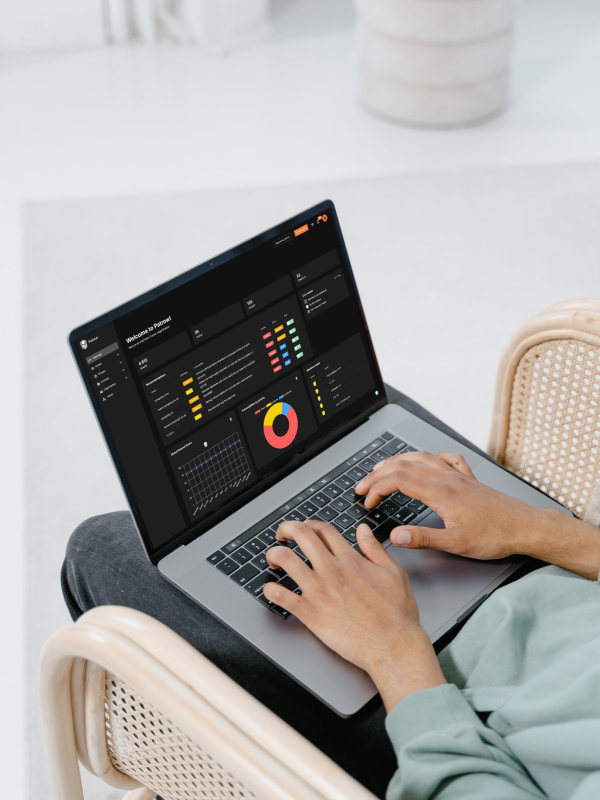
FAQ
What is a vulnerability scanner?
A vulnerability scanner is cybersecurity software designed to identify security flaws in networks, applications or computer systems. Detecting these vulnerabilities is crucial to protect against cyber-attacks.
Cybercriminals often exploit software vulnerabilities to carry out their attacks. To protect their infrastructure, companies therefore need to carry out regular scans to identify and mitigate these vulnerabilities.
According to the Center for Internet Security (CIS), it is advisable to carry out inspections on a weekly basis, or even more frequently. This preventive task can be automated using a vulnerability scanner, a tool widely used in the IT industry. These scanners are essential for preventing cyber-attacks, as they enable networks, applications, systems and IT equipment to be analyzed.
What are the main benefits of vulnerability scanners?
Vulnerability scanners are defensive tools designed to identify a company's vulnerabilities:
Mapping of external and internal assets.
Verification of database trees, web applications and operating systems.
Activation of the necessary security modules to perform tests and identify weaknesses.
Production of a security report to facilitate the implementation of corrective measures.
Types of vulnerability scanners:
The market offers a variety of free and paid vulnerability scanners, each with its own specific features. The choice of scanner depends on the type of system to be scanned. Commonly used types include :
Web application vulnerability scanners
Vulnerability scanners for open-source applications
Network application vulnerability scanners
Companies can perform security scans in two ways:
Unauthenticated scans: simulate the approach of an intruder.
Authenticated scans: involve logging on to the network as a user.
These methods can be used independently or in conjunction with each other to identify security vulnerabilities in different contexts.
How often should systems be scanned?
It is recommended to scan your systems at least once a week, or even daily for high-risk companies or those handling sensitive data. Regular scanning ensures rapid identification of vulnerabilities.
Which vulnerabilities are most frequently detected?
The most common vulnerabilities include :
Configuration flaws (incorrect system settings).
Unpatched known vulnerabilities (CVEs).
Web application vulnerabilities (SQL injections, XSS).
Unsecured or insufficiently protected access.
How to use these tools effectively?
Schedule regular scans to ensure proactive detection of vulnerabilities.
Configure the platform correctly to avoid false positives and cover the entire perimeter.
Analyze results carefully and prioritize patches according to risk level.
Complement analyses with regular pentests for a more in-depth approach.
Train your teams to take full advantage of the platform's functionalities and guarantee optimal use.
With Patrowl, you benefit from a platform that acts like a continuous audit, with no time limits, greater efficiency and significantly lower costs!

